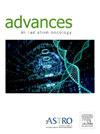First-in-Men Online Adaptive Robotic Stereotactic Body Radiation Therapy: Toward Ultrahypofractionation for High-Risk Prostate Cancer Patients
IF 2.2
Q3 ONCOLOGY
引用次数: 0
Abstract
Purpose
Ultrahypofractionation presents challenges for a subset of high-risk prostate cancer patients due to the large planning target volume (PTV) margin required for the seminal vesicles. Online adaptive radiation therapy could potentially reduce this margin. This paper focuses on the development, preclinical validation, and clinical testing of online adaptive robotic stereotactic body radiation therapy for this patient group.
Methods and Materials
An online adaptive workflow was developed for the CyberKnife with integrated in-room CT-on-rails. Preclinical validation involved comparing deep learning–based auto-contouring with deformable or rigid contour propagation in terms of subsequent editing time. A fast treatment planning method was implemented and compared with the conventional method in terms of optimization time and adherence to planning constraints. Clinical testing was conducted in the first study patients of the UPRATE trial, which investigates the feasibility of seminal vesicle PTV margin reduction in low-volume metastasized prostate cancer patients. Treatment time and patient experience were recorded.
Results
Rigid registration for prostate and deep-learning auto-contouring for seminal vesicles and organs at risk were selected based on editing time and robustness for anatomic changes. The fast treatment planning method reduced the optimization time from 10 to 3.5 minutes (P = .005). No significant differences in dose parameters were observed compared with the conventional plans. During clinical testing, 53 of 60 fast treatment plans adhered to the planning constraints, and all 60 were clinically accepted and delivered. The average total treatment time was 67.7 minutes, showing a downward trend. The treatment was well-experienced overall.
Conclusions
Online adaptive stereotactic body radiation therapy using CyberKnife with integrated CT-on-rails is clinically feasible for prostate cancer patients with seminal vesicles included in the target volume. The UPRATE trial outcome will reveal the extent to which online adaptation can reduce the PTV margin of the seminal vesicles.
男性首次在线自适应机器人立体定向放射治疗:对高危前列腺癌患者进行超低分割。
目的:由于精囊所需的大计划靶体积(PTV)范围,超低分割对高危前列腺癌患者提出了挑战。在线适应性放射治疗可能会减少这一差距。本文重点介绍了针对该患者群体的在线自适应机器人立体定向放射治疗的开发、临床前验证和临床测试。方法和材料:为集成室内CT-on-rails的射波刀开发了在线自适应工作流程。临床前验证涉及在随后的编辑时间方面比较基于深度学习的自动轮廓与可变形或刚性轮廓传播。实现了一种快速治疗计划方法,并与传统方法在优化时间和遵守计划约束方面进行了比较。在upate试验的第一批研究患者中进行了临床试验,该试验探讨了小体积转移性前列腺癌患者精囊PTV边缘缩小的可行性。记录治疗时间和患者经历。结果:根据编辑时间和对解剖变化的鲁棒性,选择了前列腺的刚性注册和精囊和危险器官的深度学习自动轮廓。快速治疗计划法将优化时间从10分钟缩短至3.5分钟(P = 0.005)。与常规方案相比,剂量参数无显著差异。在临床试验中,60个快速治疗方案中有53个方案符合计划约束,60个方案均被临床接受并交付。平均总治疗时间为67.7 min,呈下降趋势。总的来说,治疗经验丰富。结论:应用射波刀联合CT-on-rails在线自适应立体定向放射治疗靶体积包括精囊的前列腺癌患者在临床上是可行的。UPRATE试验结果将揭示在线适应在多大程度上可以减少精囊的PTV边缘。
本文章由计算机程序翻译,如有差异,请以英文原文为准。
求助全文
约1分钟内获得全文
求助全文
来源期刊

Advances in Radiation Oncology
Medicine-Radiology, Nuclear Medicine and Imaging
CiteScore
4.60
自引率
4.30%
发文量
208
审稿时长
98 days
期刊介绍:
The purpose of Advances is to provide information for clinicians who use radiation therapy by publishing: Clinical trial reports and reanalyses. Basic science original reports. Manuscripts examining health services research, comparative and cost effectiveness research, and systematic reviews. Case reports documenting unusual problems and solutions. High quality multi and single institutional series, as well as other novel retrospective hypothesis generating series. Timely critical reviews on important topics in radiation oncology, such as side effects. Articles reporting the natural history of disease and patterns of failure, particularly as they relate to treatment volume delineation. Articles on safety and quality in radiation therapy. Essays on clinical experience. Articles on practice transformation in radiation oncology, in particular: Aspects of health policy that may impact the future practice of radiation oncology. How information technology, such as data analytics and systems innovations, will change radiation oncology practice. Articles on imaging as they relate to radiation therapy treatment.
 求助内容:
求助内容: 应助结果提醒方式:
应助结果提醒方式:


